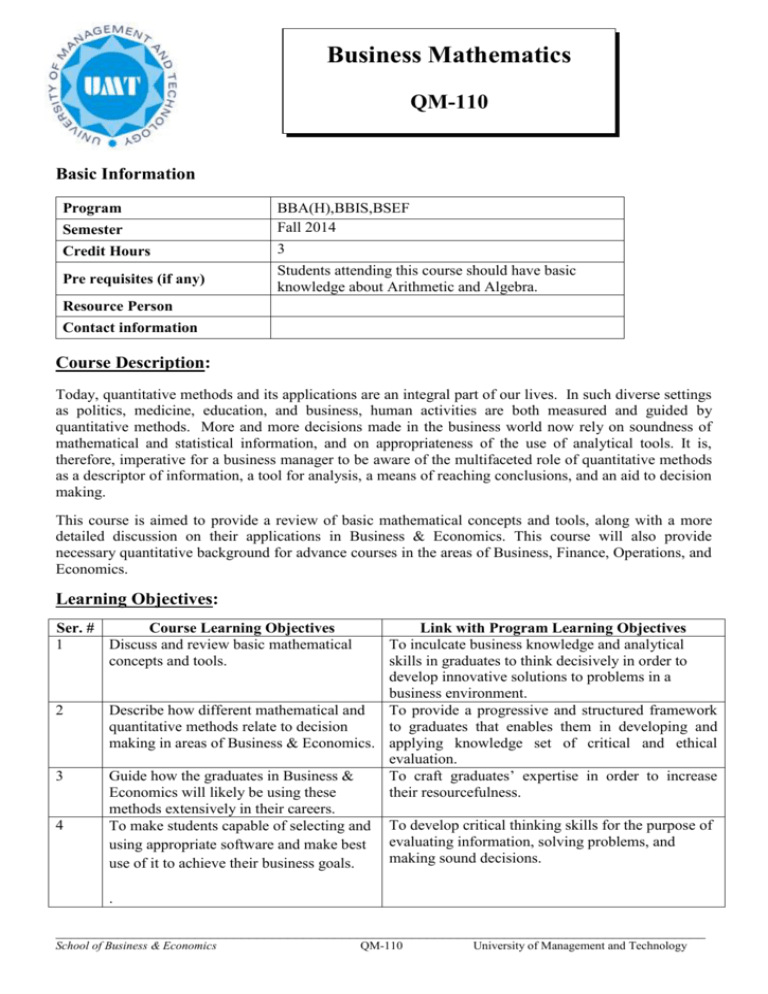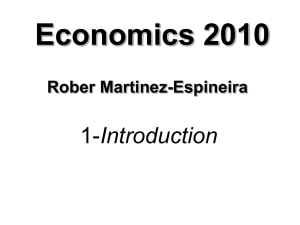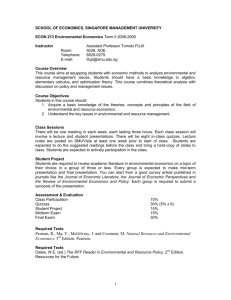This course is aimed to provide a review of basic mathematical
advertisement

Business Mathematics QM-110 Basic Information Semester BBA(H),BBIS,BSEF Fall 2014 Credit Hours 3 Pre requisites (if any) Students attending this course should have basic knowledge about Arithmetic and Algebra. Program Resource Person Contact information Course Description: Today, quantitative methods and its applications are an integral part of our lives. In such diverse settings as politics, medicine, education, and business, human activities are both measured and guided by quantitative methods. More and more decisions made in the business world now rely on soundness of mathematical and statistical information, and on appropriateness of the use of analytical tools. It is, therefore, imperative for a business manager to be aware of the multifaceted role of quantitative methods as a descriptor of information, a tool for analysis, a means of reaching conclusions, and an aid to decision making. This course is aimed to provide a review of basic mathematical concepts and tools, along with a more detailed discussion on their applications in Business & Economics. This course will also provide necessary quantitative background for advance courses in the areas of Business, Finance, Operations, and Economics. Learning Objectives: Ser. # Course Learning Objectives 1 Discuss and review basic mathematical concepts and tools. 2 3 4 Link with Program Learning Objectives To inculcate business knowledge and analytical skills in graduates to think decisively in order to develop innovative solutions to problems in a business environment. Describe how different mathematical and To provide a progressive and structured framework quantitative methods relate to decision to graduates that enables them in developing and making in areas of Business & Economics. applying knowledge set of critical and ethical evaluation. Guide how the graduates in Business & To craft graduates’ expertise in order to increase Economics will likely be using these their resourcefulness. methods extensively in their careers. To make students capable of selecting and To develop critical thinking skills for the purpose of using appropriate software and make best evaluating information, solving problems, and making sound decisions. use of it to achieve their business goals. . ____________________________________________________________________________________ School of Business & Economics QM-110 University of Management and Technology Textbooks & Supplies: 1. Essential of College Mathematics (For Business & Economics) (11th Edition) By: Raymond A. Barnett, Michael R. Zeigler Supplementary Material: 2. Applied Mathematics for Business, Economics, and the social sciences By: Frank Web links: moodle.umt.edu.pk Email Addresses Participants should establish their email accounts on the UMT email system, and use this address for all types of academic communications during this course. Moodle Participants should regularly visit the course website on MOODLE Course Management system, and fully benefit from its capabilities Classroom Behavior: Positive and constructive class participation will be monitored for each class. Particular emphasis will be given during the presentation sessions. The manner in which the question is asked or answered will also be noted. Your behaviour, as business executive will contribute to the class participation marks. Participant Responsibilities: The learning process is based on independent work with texts, textbook, and cases supported by lectures and assignments/cases - see schedule. Participants are supposed to have read the text chapters under discussion in advance. Questions answered to these text chapters, will contribute to the class participation marks. Use of Unfair Means Participants are expected to do their own work in their assignments, quizzes and exams. They are always encouraged to discuss with each other but the assignments, quizzes and exams should be their own work reflecting their own effort and intellect. The School of Business & Economics is VERY STRICT against any action of plagiarism, copying and cheating. So don’t put yourself in any embarrassing position that may mar your career. In summary, any or all of these actions may be taken against you in case of cheating. Zero Point for the assignment/quiz/exam Case would be sent to UMC Committee ____________________________________________________________________________________ School of Business & Economics QM-110 University of Management and Technology Use of Mobile Phones and Other Electronic Devices Use of mobile phones and similar devices is prohibited during the class Your phone should not be heard or visible during the class All mobile phones should be turned-off (or at least in the “silent” mode) and secured in pockets or bags during the class time, and may not be used for ANY purpose, including calculations, time-keeping, etc. In case you are anticipating an emergency call, you need to discuss this matter with the resource person BEFORE the start of the class Entering and Leaving the Classroom You are requested to seek permission from the resource person while entering or leaving the classroom during the session Tests and Grading: According to new grading policy participants are supposed to obtain 50% marks in 70% evaluation and 50% marks in their final exam. Passing marks are 50% of total assessment. Quizzes/Class Participation: Quizzes will be taken according to calendar of activities. The quizzes are aimed at evaluating the participants’ understanding and clarity of different concepts. Some corrective action will be taken if necessary, to fill the gap between desired and actual. Surprise quizzes may also be taken. Required Material for QM-110 Participants are required to bring the following in every class they come to attend: 1. Textbook 2. Calculator 3. Ring file (for notes) 4. Lead pencil (and accessories) (optional) NOTE: Failure to bring any of the first three things or being absent or late in a class, may result in a loss of marks in your class participation, and may adversely affect your final grade. Assessment Mode and Weightage 1. Quizzes 20% 2. Assignments 15% 3. Project/Presentation 10% 4. Class Participation 5% 5. Mid Term 20% 6. End Term 30% ____________________________________________________________________________________ School of Business & Economics QM-110 University of Management and Technology Calendar of Activities Sess. 1-2 Topics to be Covered Preliminaries: Algebra and Real Numbers Operations on polynomials Factoring polynomials Operation on Rational Expressions Integer Exponents and Scientific Notation Readings & Page Numbers Appendix A Page: 903-942 Raymond A. Barnett Expected Quizzes Assignments and Problems Business, economics & finance applications discussions 3–6 Linear Equations and its Graphs Purchase Price and Consumer Price Index Graphs and Lines Cartesian Coordinate System Applications related to Production, Cost, and Supply & Demand Situations Ratios, Proportions: 7-8 Rate and Ratio Defining Proportion Proportional Parts and their use Indirect Proportion Compound Proportion CH:1 Page: 2- 29 Raymond A. Barnett Handout Page: 48-50 . Harwood Clarke Business, economics & finance applications discussions Assignment # 2 Quiz # 1 Business, economics & finance applications discussions Quiz # 2 Percentages: 9-10 Defining Percentage Difference between Percentage and Proportion Percentage Gain and its Business Use Percentage Loss and its Business Use Mathematical Functions: 11-14 15-16 Function Elementary Functions: Graphs and Transformations Quadratic Function Exponential Function Logarithmic Function Handout Page: 50-56 . Harwood Clarke CH:2 Page: 46 - 127 Raymond A. Barnett To review the basic concepts of mathematics, identifying and solving equations and inequalities and their use in business. Assignment # 1 Linear Equations and Graphs: Learning objective Business, economics & finance applications discussions Business, economics & finance applications discussions To discuss some algebraic methods for solving equations and to introduce coordinate system to explore the relationship between algebra and geometry, to use this algebraic-geometric relationship to find mathematical models for describing real-world data sets. To learn how the concept of ratios and percentages can be helpful in different business, economics and finance related situations and also the situations where proportions will serve effective purposes. To be able to learn understand the concept of percentage and its use of computing percentage gain and loss in different business and economics situations. To develop functions and identifying their types, how to apply functions in real life, to use functions to check the linear and Assignment # 3 curved trend in data. Quiz # 3 Review Session Mid Term ____________________________________________________________________________________ School of Business & Economics QM-110 University of Management and Technology System of linear Equations; Matrices: 17-19 System of Linear Equations in Two Variables System of Linear Equations and Augmented Matrices Gauss-Jordan Elimination Matrices: Basic Operations Inverse of a Square Matrix Matrix Equations and Systems of linear Equations CH:4 Page: 175-236 Raymond A. Barnett Business, economics & finance applications discussions Assignment # 4 Quiz # 4 To review how systems of linear equations involving two variables are solved, to turn to different method of solution involving the concept of an augmented matrix, to study matrices and matrix operations, applications to important economics problem.. Mathematics of Finance: 20-24 25-27 Simple Interest and Return on Investments Compound Interest and Continue Compound Interest Computing Growth Rate and Annual Percentage Yield Annuity, types of annuity, Ordinary Annuity and Annuity Due Future Value of an Annuity; Sinking Funds Present Value of an Annuity; Amortization and Amortization Schedules Sequence and Series: Sequence Series and Summation Notation Arithmetic Sequence Geometric Sequence CH:3 Page: 127 - 158 Business, economics & finance applications discussions Raymond A. Barnett Assignment # 5 Appendix B Business, economics & finance applications discussions Page: 952 - 965 Raymond A. Barnett Quiz # 5 To learn and understand the concepts of sequence and series and their applications in terms of loan repayment and Assignment # 5 economy stimulation. Use of Differential Calculus 28-30 The Derivative Basic differentiation properties Differentials Marginal Analysis in Business and Economics Derivatives of Products and Quotients CH:10 & 11 Page: 539 - 569 & 602 Raymond A. Barnett To be able to understand the concepts of simple, compound interests, annuities, sinking funds, amortization, and amortization schedules, to develop formulas and compute their values under different business, economics and finance situations. Business, economics & finance applications discussions Quiz # 6 To introduce and understand the concept of derivatives and to learn how the manufacturing companies can know in advance the increase in cost, revenue and ultimately profit by taking help from their marginal functions and can make effective decisions. ____________________________________________________________________________________ School of Business & Economics QM-110 University of Management and Technology







